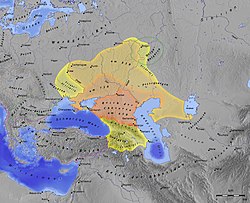Second Arab–Khazar War
| Arab–Khazar wars | |||||||
|---|---|---|---|---|---|---|---|
| Part of the Muslim conquests | |||||||
 Map of the Khazar Khaganate in the 7th–9th centuries |
|||||||
|
|||||||
| Belligerents | |||||||
| Khazar Khaganate | Umayyad Caliphate (and later Abbasid Caliphate) | ||||||
| Commanders and leaders | |||||||
|
Alp Tarkhan Barjik † Hazer Tarkhan † Ras Tarkhan |
Abd ar-Rahman ibn Rabiah Maslama ibn Abd al-Malik al-Jarrah ibn Abdallah † Sa'id ibn Amr al-Harashi Marwan ibn Muhammad Yazid al-Sulami |
||||||
The Arab–Khazar wars were a series of conflicts fought between the armies of the Khazar Khaganate and the Umayyad Caliphate (as well as its Abbasid successor) and their respective vassals. Historians usually distinguish two major periods of conflict, the First (сa. 642–652) and Second (ca. 722–737) Arab–Khazar Wars, but the Arab–Khazar military confrontation involved several sporadic raids and isolated clashes as well, over a period from the middle of the 7th century to the end of the 8th century.
The Arab–Khazar wars were a result of the attempts of the Umayyad Caliphate to secure control of Transcaucasia and the North Caucasus, where the Khazars were already established. The first Arab invasion, in the 640s and early 650s, ended with the defeat of an Arab force led by Abd ar-Rahman ibn Rabiah outside the Khazar town of Balanjar. Hostilities broke out again with the Caliphate in the 710s, with raids back and forth across the Caucasus. Led by the distinguished generals al-Jarrah ibn Abdallah and Maslama ibn Abd al-Malik, the Arabs were able to capture Derbent and even the southern Khazar capital of Balanjar, but this had little impact on the nomadic Khazars, who remained able to launch devastating raids deep into Transcaucasia. In one such raid in 730, the Khazars inflicted a major defeat on the Umayyad forces at the Battle of Ardabil, killing al-Jarrah, but were in turn defeated the next year and pushed back north. Maslama then recovered Derbent, which became a major Arab military outpost and colony, before being replaced by Marwan ibn Muhammad (the future caliph Marwan II) in 732. A period of relatively localized warfare followed until 737, when Marwan led north a massive expedition that reached the Khazar capital Atil on the Volga. After securing some form of submission by the khagan, the Arabs withdrew.
The 737 campaign marked the end of large-scale warfare between the two powers, establishing Derbent as the northernmost Muslim outpost and securing Muslim dominance over Transcaucasia. At the same time, the long wars weakened the Umayyad army and contributed to the eventual fall of the dynasty to the Abbasid Revolution a few years later. Relations between the Muslims of the Caucasus and the Khazars remained largely peaceful thereafter, apart from two Khazar raids in the 760s and in 799, resulting from failed efforts to secure a alliance through marriage between the Arab governors or local princes of the Caucasus and the Khazar khagan. Occasional warfare continued in the region between the Khazars and the local Muslim principalities of the Caucasus until the collapse of the Khazar state in the late 10th century, but the great wars of the 8th century were never repeated.
...
Wikipedia
